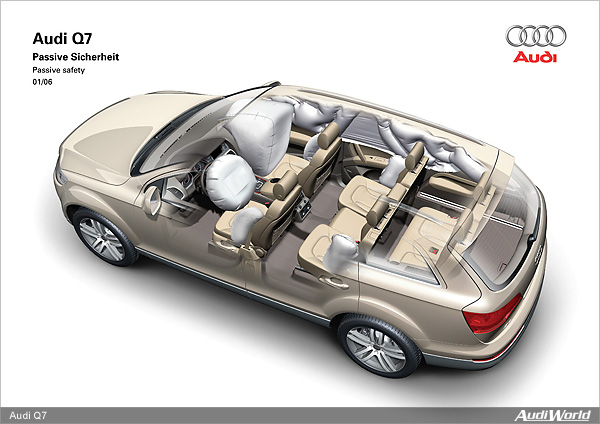The Audi Q7: Body

Strong and safe The dimensions of the Audi Q7 are not its only impressive feature its spacious body is extremely rigid, robust and safe. State-of-the-art restraint systems protect passengers in the event of an accident. The Audi Q7 is a vehicle of prestigious proportions even in the premium SUV category. It is 5,086 millimetres long and has a wheelbase of 3,002 mm figures that put it ahead of the competition. The width of 1,983 mm and the height of 1,737 mm (with steel chassis) are an indication of the superb spaciousness offered by the interior. A primary development goal was to achieve maximum static and dynamic rigidity for the unitised body. Audi engineers have accomplished this with an elaborate lightweight steel construction. 26 per cent of all components are of high-strength steel and 32 per cent are even made of the very high and ultra-high-strength varieties. In some areas such as the floor cover, ultra-modern tailored blanks are used, the various strengths of which are created in the rolling process. Six per cent of the body components are made of aluminium these are the wings, the engine compartment lid and the tailgate. Compared with conventional components made of steel panels, Audi has achieved a weight saving of 22 kilograms. In order to produce this unusually flowing design for the tailgate the expertise in lightweight aluminium construction gained by the brand over many years was required. The aluminium tailgate alone reduced the weight by around 7.5 kilograms, another advantage of this being that the customer requires less force to open and close it. With the V8 petrol engine the Audi Q7 tips the scales at 2,165 kilograms. Bonding, laser welding and laser soldering During assembly of the performance SUV, cutting edge procedures and joining techniques such as laser welding and laser soldering are applied. Evidence of this high standard of quality can be seen from the body surface and its precise and narrow seams. Areas subject to the greatest load were joined over a length of almost 80 metres using spot-welding technology; laser welds of 2.2 m in length will be found on the roof frame. High body rigidity is a prerequisite for dynamic on-road handling and diverse off-road qualities. At the same time it ensures good vibrational behaviour, making the Audi Q7 an exceptionally quiet and comfortable vehicle. Crash protection of the highest standard With regard to occupant safety too, the body of the Audi Q7 offers a standard in line with the high claim of the brand. Zones with precisely defined deformation behaviour in all sections reduce the impact energy in a controlled way so that the high-strength occupant cell can provide maximum survival space. In the event of a frontal collision, front sensors near the headlights, in conjunction with other sensors on the B- and C-pillars, register a crash within the space of a few thousandths of a second. A few milliseconds later, the control unit triggers the belt tensioners to minimise any possible belt slack. A belt-force limiter yields at a particular load threshold to allow occupants to sink into the inflated airbag. Belt-force limiters are also standard on the outer seats of the second row. The full-size front airbags function in two stages. Padding absorbs energy To a large extent, the steering wheel and the drivers airbag retain their position during a collision thanks to a sliding mechanism incorporating a damping function which is connected to the steering column. Energy-absorbing padding under the instrument panel, in the footwell and carpet protects the legs and feet; a device in the foot controls decouples the pedals. With regard to the vehicle body, a system of supports in the front section, some of which are made of ultra-high-strength steel, absorb the impact impulse. The bumper beam distributes the forces evenly and directs them specifically to the side members, which are matched in terms of behaviour to the bulkhead and the vehicle floor. The sills including inner reinforcement tubes, the columns of high-strength steel and the roof frame profile extending from the A- to the D-pillar distribute the remaining forces in such a way that the load to which the passenger cell is subjected is kept low. In the event of a side collision other protective components in the body come into play. The doors overlap with the sidewall frame, their panels are extremely deformable in particular areas. The front seat frames remain rigid thanks to particularly stiff cross braces.
sideguard head airbags for all three seat rows The occupant cell of the Audi Q7 is naturally equipped as standard with side airbags at the front, which protect the chest and pelvis of the occupants. As an option, these airbags are also available for the outer seats in the second row. Standard on the other hand is the head-protection airbag system sideguard, which completely covers the entire side window area up to the third seat row. The airbags are filled by a hybrid gas generator. Once triggered they do not deflate immediately this longer period of use offers protection in the event of a secondary collision. The new Audi Q7 also affords its passengers excellent protection against the consequences of a rear-end collision. It already meets the requirements of future standards, i.e. it withstands an impact against a deformable barrier at 80 km/h and with 70 per cent overlap. The compact assemblies with the resulting deformation area under the Q7s high engine compartment lid have a beneficial effect in terms of pedestrian protection. |

